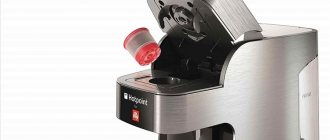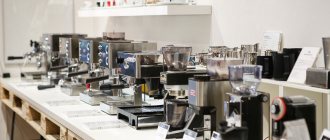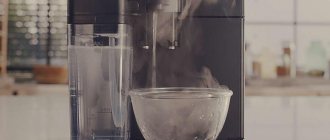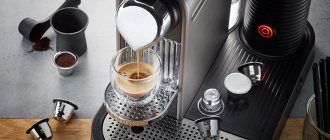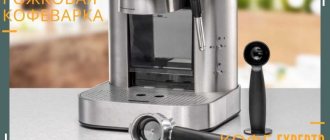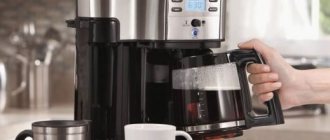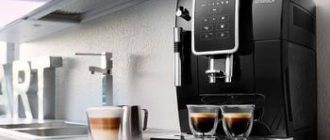Capsule coffee machines are relatively new, but they are very popular because they have many advantages. The people who created these devices made a kind of revolutionary breakthrough. And this is not surprising, because these devices have a beautiful design, are functional and easy to clean. But don't forget about the downsides.
Coffee from a coffee machine
What is a capsule coffee machine (coffee maker)?
A capsule-type coffee machine is a modern device that provides for the preparation of an aromatic drink using special capsules .
The capsule is a compact container, hermetically packaged, containing roasted ground coffee.
Note! The packaging of each capsule is filled with inert gas, so that during storage the contents do not oxidize even under mechanical stress.
A capsule coffee maker is an ideal option for those who want to enjoy aromatic coffee without spending a lot of time on subsequent cleaning of the equipment.
Principle of operation:
- A special tank, which is usually located at the back wall, is filled with water.
- A cup is placed and the type of drink is selected.
- The pump pumps water into the tank, during the process it heats up to the required temperature, but does not boil.
- The capsule is pierced and hot water flows through the coffee beans.
- The ground grains are brewed and the liquid is filtered.
For your information! Depending on the type of coffee machine, the capsule will be ejected automatically or will need to be done manually.
Three minutes of history: how the “coffee wars” led to product improvements
The coffee capsule was invented by the Swiss Eric Favre, who worked as an engineer at the legendary company Nestlé. This happened by chance: Eric and his wife were on vacation in Italy and tried incredibly delicious espresso in one of the Roman coffee shops. Favre decided to find out the secret of the recipe, and eventually got the barista to expose the coffee to hot steam several times, essentially enriching it with oxygen. Thanks to this, more flavoring and aromatic substances were released into the finished drink.
Returning to Switzerland after a vacation, Eric developed a new type of coffee machine and came up with capsules with ground coffee through which hot water passed under pressure. Already in 1976, a new coffee machine was presented to Nestlé management... but did not make it to the market. At the time, instant coffee reigned supreme in kitchens, so the company chose to focus on a familiar product. The invention was forgotten for another 10 years, until in 1986 Eric Favre and businessman Jean-Paul Gaillard, who became the new manager of Nespresso, began to position it not as equipment for the office, but as a simple solution for those who want to drink good espresso at home, but I’m not ready to spend time preparing it in a professional coffee machine. Favre took on all the technical work, Gaillard took up marketing strategy and began offering “capsules” as an elite solution for members of the closed Nespresso Club (to join it, you had to buy a coffee machine). And everything started to happen... Nespresso became a separate brand with huge sales (more than 700 boutiques in 68 countries), and its founders became millionaires.
However, there was a fly in the ointment. The sale of the coffee machines themselves did not bring much income to the company; the main profit came from the sale of consumables - capsules. And soon Nespresso had a bunch of competitors who produced compatible capsules, but the coffee in them was cheaper and often tastier. The main competitor, by the way, was the Ethical Coffee Company (ECC), founded by the same Jean-Paul Gaillard, who left Nespresso due to a scandal with management. He offered biodegradable capsules, immediately hitting the pain points of customers concerned about the environment.
In the 2000s, the European market was rocked by legal battles between coffee companies over the right to produce compatible capsules. In the end, the end consumer was the winner, and now we can choose any capsules: disposable, reusable, “native” from Nestlé or from any other flavored or flavored.
Advantages and disadvantages
The advantages of capsule-type coffee makers include::
- Easy to operate . All you need to do is pour water into the compartment and remove the used capsule after cooking.
- No hassle with maintenance . It is only necessary to occasionally wipe the device from dust. The coffee maker will last a very long time, but provided that the water used for preparation is purified or well-boiled. Running water cannot be poured into the tank.
- Rich taste of the finished drink . Due to the fact that the capsules contain several types of coffee, it gets a unique, rich taste.
- Compact size . A capsule coffee maker will fit well into the interior of any kitchen. It doesn't take up much space. In addition, the original design of the device will add charm to the environment.
- Quick cooking . Within a minute after switching on, you can drink delicious coffee.
- Price . The cost of a capsule coffee maker is significantly less compared to other types of coffee machines, even the budget type.
If we talk about the disadvantages of this device, then these are:
- connection to a certain brand of coffee;
- the price of one serving of coffee is relatively high.
Reviews
Users are unanimous on one thing: the quality and taste of the resulting drink is not inferior to the taste characteristics of professional coffee machines. Those who bought the device and actively use it note its compactness, ease of use, lack of need to disassemble and wash the compartments, and speed of preparation.
Coffee lovers are also grateful to manufacturers for matching advertising promises with the actual results of the machine’s operation. The aroma and strength of the resulting drink were liked by many.
The pros and cons of a capsule coffee machine balance each other out. If you don’t have time, but have a desire to get a ready-made drink with guaranteed taste, then this type of device will live up to your expectations.
Which one to choose for your home?
The main parameters of a device that is suitable for use at home are and should be taken into account when choosing:
- Power . The speed of coffee preparation depends on it, or more precisely, the speed of heating water to the required temperature . The optimal power that is suitable for home use of a coffee maker is at least 1200 W.
- Availability of a cappuccino maker . It is a must for lovers of coffee with milk - cappuccino, latte, cocoa. However, not all capsules contain milk powder, so you can add regular milk to your pure coffee to suit your taste.
- Water tank volume . If 1-2 people plan to use the coffee machine, then a 0.5 liter tank will be sufficient. For more coffee lovers in the family, you will need a tank with a volume of at least 1 liter. It should be noted that the coffee maker cannot be turned on if there is insufficient water or its complete absence in the tank , since the device in this case will fail.
- Pressure . This parameter must be at least 15 bar. Otherwise, there will not be enough pressure to force water through the coffee capsule.
- Size . The more functions a coffee maker has (preparing various types of coffee), the larger it is. As for the coffee machine, it is quite compact. But you need to take into account that at one time she prepares only 1 serving of drink .
- Noise . Most coffee machines are quite noisy devices. However, due to the fact that the capsule cooks very quickly, this problem is not so noticeable, especially if only 1 person uses it.
- Touch display and other additional functions . If the machine has additional functions, it greatly simplifies its operation. But on the other hand, the cost of such a device can be much higher. Additional functions of capsule-type coffee makers include: the ability to adjust the height of the tray, the presence of lighting when the water tank is completely filled .
Another important function is the presence/absence of a water filter .
Important! If you use unpurified liquid when making coffee, scale will accumulate in the device if it is not equipped with a filter.
Features of work
Oddly enough, the method of making coffee from capsules is not so new - it was patented back in the seventies of the last century, and it became more widespread in the eighties. Since that time, the technology has changed more than once, has been greatly improved and has reached those devices that families with different coffee preferences, as well as with completely different incomes, can now afford to buy.
Video on the topic
Nespresso DeLonghi capsule coffee maker review
Click Play to view
It's all about the simplified operating principle of this coffee maker. Before preparation, coffee is stored in a completely sealed, conveniently packaged capsule. There are already a sufficient number of varieties in this form, and the preparation of any of them is no different from the other. After adding the capsule to the coffee maker, it is pierced and water begins to flow into the resulting hole. Within a matter of minutes, the coffee lover already receives his aromatic, freshly brewed drink.
Standard coffee machines have a number of functions and variations in setting various modes, which are very difficult for the average person to understand. Simpler models, unlike more complicated versions, cannot achieve high quality coffee, which is why they are often rejected by consumers. Capsule coffee makers solve this problem precisely because of their ease of use and the excellent quality of the resulting drink, which is no different from what a professional barista can prepare. Hermetic packaging allows you to preserve coffee for a long time without changing its properties, and correctly selected concentrations of various additives guarantee exactly the coffee that you get if you prepare it according to the classic recipe.
Coffee capsules are placed in a special compartment of the coffee maker
Kinds
There are not many manufacturers on the modern market of capsule-type coffee machines. Let's look at the most popular options.
Nespresso
This is the most common brand. very compact option that is suitable for beginner coffee lovers .
There are 17 types of capsules for this coffee maker, including decaffeinated coffee. A distinctive feature of the capsules is their material (aluminum) , which provides the best storage conditions for ground grains. The disadvantages include the absence of chocolate drinks and tea capsules in the line.
Dolce Gusto
Easy to operate device, original design. There are about 10 types of coffee intended for this coffee maker , and another 10 - various chocolate shakes, milk drinks, tea.
Attention! The disadvantages include the not very high quality of budget models, as well as the high cost of capsules intended for making tea and chocolate cocktails.
Tassimo
These coffee makers produce the largest number of capsules, thanks to which you can prepare various types of coffee, as well as tea and cocoa. The machines have a low level of pressure , but since the coffee in capsules is not compressed, a stream of water easily penetrates through it.
Cremesso
These coffee machines are characterized by minimal energy consumption and high operating pressure .
A delicious drink is prepared in no more than 30 seconds. There are 12 varieties of drinks, as well as 4 types of tea. Food-grade plastic is used to make capsules, so their cost is quite high .
As already mentioned, a significant disadvantage of capsule coffee machines is the high price of capsules and their limited quantity.
By the way! You can get away from these problems by purchasing a reusable capsule, which is a plastic or metal analogue, and the top foil is replaced with a hinged or screw-on lid with a hole for water to enter.
Popular models
| Model: | Average price (RUB): | Capsules: | Volume (l): | Pressure (bar): | Cappuccino: | Auto off: | View: |
| Nespresso Essenza Mini C30 White | 5 500 | Nespresso | 0.6 | 19 | — | + | |
| Krups KP 1002/1006/1009 | 3 500 | Dolce Gusto | 0.6 | 17 | — | + | |
| De'Longhi Inissia | 4 000 | Nespresso | 0.7 | 19 | — | + | |
| Dolce Gusto Krups Piccolo KP100B10 | 3 990 | Dolce Gusto | 0.6 | 15 | + | + | |
| De'Longhi EN 80 AE | 6 500 | Nespresso | 0.8 | 19 | + | + | |
| Bosch TAS 3202/3203/3204/3205 SUNY | 3 800 | Tassimo | 0.8 | 17 | — | + | |
| De'Longhi EN 500 | 13 500 | Nespresso | 1 | 19 | + | + | |
| Bosch TAS 6002/6003/6004 My Way | 9 990 | Tassimo | 1.3 | 19 | + | + | |
| Bosch TAS 1402/1403/1404/1407 | 3 500 | Tassimo | 0.7 | 17 | — | + | |
| De'Longhi EN 85 Essenza Mini | 8 990 | Nespresso | 0.6 | 19 | + | + |
Features of Dolce Gusto coffee machines
Automatic capsule coffee makers for home, produced under the Dolce Gusto brand, differ from Nespresso coffee machines in a more affordable price. They are manufactured on modern equipment of the French concern Krups. The simplest models can be selected and purchased for 4 thousand rubles, but for a more functional and high-quality device you will have to pay about 15 thousand rubles.
Since the cost of such models for home use is quite low, this is reflected in the quality and characteristics of coffee machines. The water flow in them is supplied using a pump under a pressure of only 15 atmospheres, and the fitting of the parts is not precise, which affects the service life of the devices.
Dolce Gusto products are distinguished by a variety of tastes. A total of 25 types of capsules are produced, 13 of which are intended for preparing traditional coffee. From the rest you can choose coffee with milk, tea latte or hot chocolate. Capsules intended for one cup of espresso contain 6 g of filler, and for a serving of Americano or cappuccino - 10 g.
All types of capsules can be purchased at an affordable price. As a rule, they are sold in sets of 16 pieces, and their cost varies from 300 to 500 rubles. It turns out that one cup of drink costs about 25 rubles. For drinks with milk, you will need to purchase additional capsules filled with milk powder. Consequently, the cost of a portion will almost double.
To summarize, we can say that the main advantages of this brand are:
- a wide variety of coffee types;
- affordable price for one serving;
- low cost of a coffee machine for home;
- the ability to prepare dairy drinks even in the simplest home appliances.
To choose a good model, you need to consider not only the pros, but also the cons of these devices. Their disadvantage is considered to be the low build quality of coffee machines, which affects their reliability. Also, the disadvantages include the small volume of filler in capsules, as well as the high cost of a serving of cappuccino or other dairy drinks.
How to prepare coffee capsules
Brewing capsule coffee in a special coffee machine is completely automatic. The user only needs to charge the capsule and press the start button.
The capsule shell is pierced inside the coffee machine with a needle. Through the same needle, hot water flows into the hole under a pressure of 15-19 bar. Hot water under pressure passes through the capsule with ground coffee and the drink is brewed. The brewing process itself is similar to how coffee is brewed in traditional espresso machines. But with capsules everything happens much easier and faster for the user.
Main types of capsules
Manufacturers of capsule coffee machines currently produce three types of capsules, for the manufacture of which different materials are used:
- aluminum, manufactured by most companies;
- polymer, produced using food-grade plastic;
- combined, consisting of aluminum, polymers and pressed paper.
In the latter case, the role of a filter is played by food polymer fibers or fluffed cellulose.
Each capsule contains 6-9 grams of ground coffee, which is enough for one cup of drink. In order to achieve optimal taste and aroma, manufacturers carefully select the degree of grinding of the powder. Depending on the type of capsule, it can contain not only coffee and additional additives, but also tea or cocoa powder. The ability to prepare various types of drinks significantly increases the functionality of the device.
